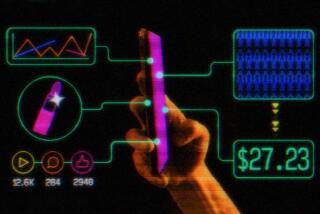Rufus Cuff smartwatch is one of 443 crowd-funded hardware projects
Tired of staring at his phone screen all day, Gabe Grifoni set out to return “humans back to being humans” by creating a smarter screen.
Grifoni designed the Rufus Cuff, a giant wrist-worn screen that he hopes someday will replace the need for smartphones, wallets, watches and other gadgetry.
“It’s not just a glorified notification center that can take your pulse,” he said of the cuff. “We’re getting ready for the revolution of everything coming out your pockets.”
But to manufacture and market the Rufus Cuff, the former actor, writer and production assistant needed more support than what a few angel investors provided. So like many entrepreneurs trying to build hardware, the Los Angeles resident turned to crowd-funding.
Through crowd-funding websites Kickstarter and Indiegogo, 443 hardware projects have raised at least $100,000 each from regular people around the world. Combining crowd-funding and venture capital funding, they’ve raised $321 million, according to a report released Monday by startup tracking firm CB Insights.
In exchange for agreeing to fund the idea, backers typically receive perks such as first access to the devices, discounts or a special version.
Crowd-funding fuels feedback and usage ideas that entrepreneurs hadn’t considered and quickly gives them sales data to showcase to investors. About one in 10 of the 443 hardware startups went on to raise venture capital funding, according to the CB Insights analysis.
At the top of list was a $75-million investment in Oculus VR before the Irvine startup sold to Facebook for $2 billion earlier this year. In 2004, more than $56 million has flowed from venture capital funds to crowd-funded hardware projects.
Grifoni hopes to soon join that list. Enticed by lower fees, he was one of 78 people to list a hardware project on Indiegogo and earn six figures. In fact, the cuff raised $359,500 from about 2,000 supporters. He and his team of about 15 people moved to an office near the The Grove shopping mall and are planning to ship the first batch of cuffs by the end of the year.
People awaiting those shipments include a 15-year-old who saved his allowance to buy a cuff, an individual with disabilities who hopes the cuff can make it easier to communicate and IT workers at major companies, Grifoni said.
Inspiration for the cuff came from spending part of his childhood in Italy, away from the buzz of Manhattan.
“There’s something about that world over there where people sat around and talked for hours versus the hustle and bustle and craziness of New York,” Grifoni said. “Technology just needs to be built the right way, and it can stop us from a ‘Wall-E’ future where we’re all staring at screens.”
For example, rather than have to look down at a maps app on a phone for directions, the Cuff could someday vibrate in a certain spot to nudge the wearer in that direction.
The initial Cuff, selling for $279, will connect to Wi-Fi on its own and to phones via Bluetooth. Grifoni wants the next version to have a cellular radio, eliminating the need to carry around a smartphone. A 3-inch screen makes it easier to type on than existing smartwatches, such as the 1.63-inch-screened Samsung Galaxy Gear.
The Cuff’s stiffest competition could come from Kickstarter-funded Neptune Pine, which started shipping last week with a 2.4-inch display.
Venture capitalist Matthew Witheiler recently analyzed the same crowd-funding data as CB Insights and found that the largest chunk of money for hardware projects -- about 20% -- went to wearable technology such as the Pine and Rufus Cuff.
Chat with me on Twitter @peard33







